Customer support vs. customer service: What’s the difference?

The difference between customer support vs. customer service in a nutshell
Although “customer support” and “customer service” are often used interchangeably, the two concepts embody subtle differences. Customer support provides customers with specialized assistance with the company’s products or services and is reactive in nature. It usually comes into play after a customer has reached out to an organization’s support team with a question.
Customer service, on the other hand, is an umbrella term that encompasses all activities that contribute to a customer’s overall experience with a brand throughout their relationship with the company.
Customer support vs. customer service
In a nutshell, customer support focuses on resolving specific technical issues or problems customers face with a product. Customer service is broader, aiming to enhance the overall customer experience by assisting with general inquiries and fostering long-term positive relationships.
Here’s a quick snapshot of the difference between customer support vs. customer service:
Customer support vs. customer service: At a glance

Remember that customer service is an umbrella term that encompasses customer support. Customer support is a type of customer service. With increasingly ubiquitous tools, such as AI chatbots and support chat software, it’s easier and more efficient to deliver exceptional service to your customers today.

Empower your support agents with AI
In this blog, we’ll discuss the differences between customer support vs. customer service and look at examples of excellent customer support and customer service. We’ll also share best practices for businesses looking to excel in both customer support and customer service — from AI customer service chatbots to all-in-one customer support platforms like Sendbird Desk. Let’s start by answering the question, “What is customer support?”
What is customer support?
Customer support is the assistance a company provides its customers in the short term to answer questions, resolve issues, troubleshoot problems, and enhance their experience with a product or service. This support is typically reactive in response to a customer support request and involves direct interaction between the customer support team and the customer to address immediate concerns.
Customer support often involves:
Technical assistance with product installation, configuration, onboarding, and usage
Troubleshooting and resolving specific issues with a company’s products or services
Providing detailed and specific solutions to customer problems
This type of product or technical customer support is most common among technology, Software-as-a-Service (SaaS), and ecommerce/retail companies that must respond quickly to ad hoc customer issues. Customer support involves direct interaction through various channels, such as phone, email, in-app chat, AI chatbots, social media, or specialized AI support chat. Effective customer support aims to address customer needs promptly and professionally to ensure satisfaction and loyalty.
For example, if a customer encounters a bug while using a CRM system, they submit a support ticket, and the customer support team guides the customer through the steps to fix the issue.

Empower your support agents with AI
What is customer service?
Customer service is an umbrella term that encompasses a wide range of activities designed to deliver an excellent customer experience overall and ensure customers’ satisfaction in the long term. Customer service is proactive and involves various activities aimed at enhancing customer satisfaction, such as answering inquiries, guiding decision-making, and resolving concerns. It involves various teams, one of which is customer support.
Customer service focuses on building long-term customer relationships through various touchpoints before, during, and after their interactions with the company. Effective customer service fosters positive relationships and helps build customer loyalty.
Customer service includes:
Handling general inquiries
Offering personalized recommendations based on customer preferences or needs
Assisting with transactions (returns, refunds)
Creating a positive brand experience through friendly and attentive interactions
Building long-term relationships through customer loyalty programs or special offers
Handling escalations related to dissatisfaction or negative experiences, aiming to regain customer trust
Ensuring overall customer satisfaction
An example of customer service is when a representative for an eCommerce brand assists a customer in choosing the best product for their needs and then follows up after their purchase to make sure that they're satisfied.
Let’s revisit the CRM software example. For a SaaS company such as this, one aspect of customer service might involve onboarding calls with the new customers to help them get started and be successful with the product.
What is the difference between customer support vs. customer service?
Let’s dive into a head-to-head comparison to explore the differences between customer service and customer support. First, here’s a quick snapshot:
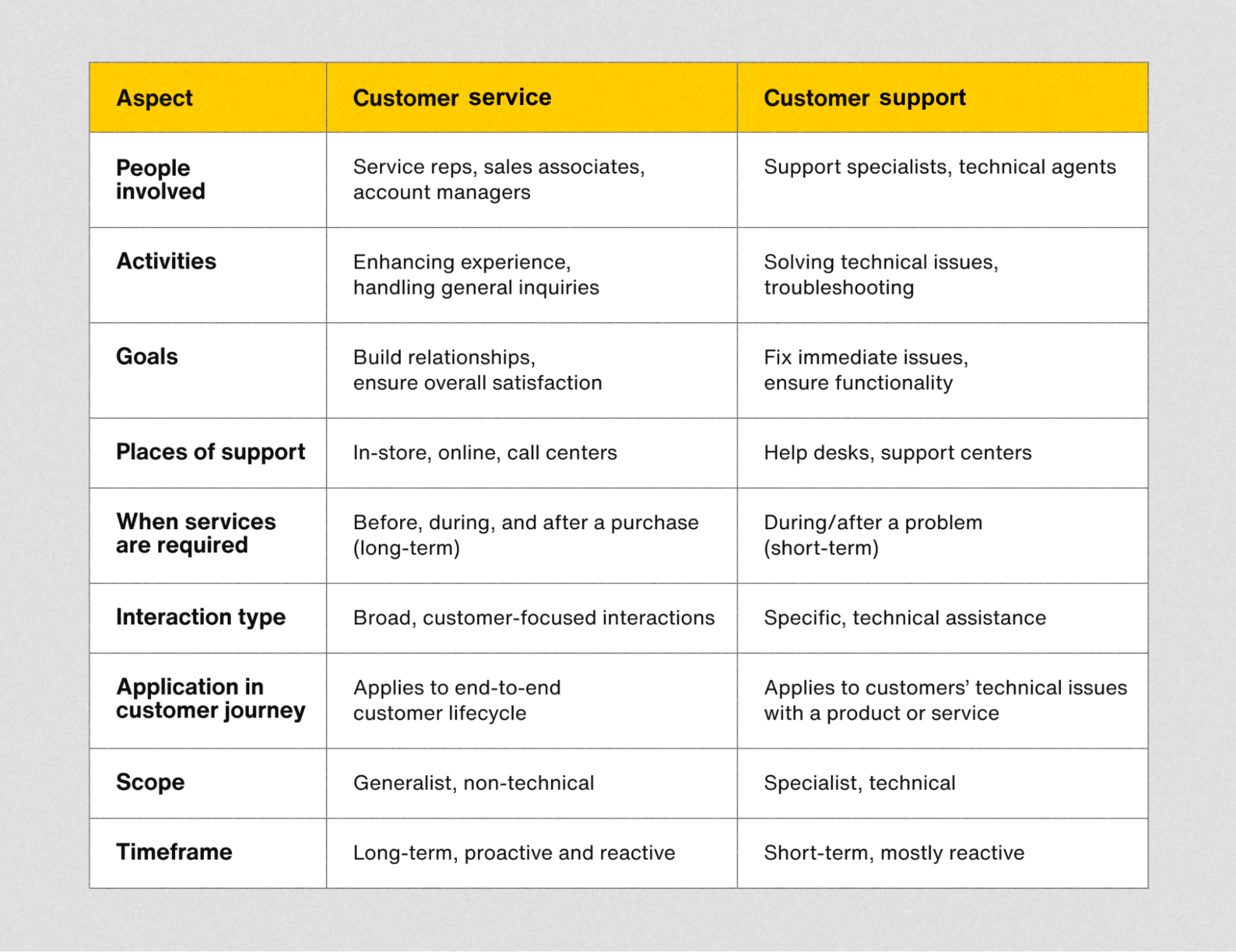
Who: People involved in customer support vs. customer service
Customer service: Customer service is usually managed by various teams, including customer service representatives, sales associates, and account/customer success professionals. These individuals are skilled in communication and customer relations, focusing on the overall customer experience rather than technical details.
Customer support: Typically, customer support is handled by support specialists or technical support agents. These individuals possess in-depth knowledge of the product or service and are trained to handle complex technical issues.
What: Customer support vs. customer support activities
Customer service: Customer service involves a broad range of activities aimed at enhancing the customer experience. This can include handling general inquiries, providing product recommendations, providing customer onboarding and training, and ensuring overall customer satisfaction.
Customer support: The focus of customer support is solving technical issues and troubleshooting problems. This could involve onboarding, guiding customers through the use of a product, or providing technical advice.
Where: Where are customer service and customer support carried out?
Customer service: Customer service engagement can take place in various settings across various channels, including in-store, online, and call centers. The goal is to be accessible to customers wherever they need assistance, whether face-to-face in a retail setting or through a quick phone call or chat.
Customer support: Customer support interactions often occur through help desks, support centers, or online platforms. These environments are designed to provide the necessary tools and resources for resolving technical issues efficiently.
When: Customer support and customer service during the customer journey
Customer service: Customer service is proactive, engaging with customers before, during, and after their interactions with the company. This ongoing support helps build relationships and fosters a positive overall experience.
Customer support: Customer support is typically reactive, coming into play during or after a problem occurs. Customers reach out to support teams when they encounter issues that need immediate resolution.
Why: The purpose of customer support and customer service
Customer service: The purpose of customer service is to build strong customer relationships and ensure satisfaction over time. By addressing needs and concerns throughout the customer journey, businesses can foster loyalty and encourage repeat business.
Customer support: The main purpose of customer support is to fix issues and ensure the product or service functions correctly. This team is crucial for maintaining the usability and reliability of the company’s offerings.
How: Interactions in customer support vs. customer service
Customer service: Customer service teams focus on broad, customer-focused interactions. They employ empathy, active listening, education, and problem-solving skills to address a wide range of customer needs and enhance the overall experience.
Customer support: Customer support teams provide specific, technical assistance tailored to resolving particular issues. This often involves detailed, step-by-step guidance and problem-solving techniques. The process can be accelerated with AI, such as an AI chatbot for customer service.

Empower your support agents with AI
Other factors differentiating customer support and customer service
Customer service: These efforts span the entire customer lifecycle and involve long-term initiatives centered on being proactive to meet customers’ needs. Customer service representatives offer general support for customers in different areas and don’t necessarily have technical product expertise.
Customer support: Support activities encompass a short-term engagement to help resolve customers’ technical difficulties with a product or service. These interactions tend to be reactive in nature and require technical expertise from specialized support staff.
By understanding these differences and developing the respective teams to fulfill both customer support and customer service needs, businesses can ensure that technical problems are swiftly resolved and customers feel valued and supported throughout their relationship with the company.
5 examples of the best customer support & customer service
It can be helpful to get inspiration when building out or improving customer service and customer support programs. Let’s look at five brands that stand out for their exemplary customer support and customer service.
Customer support
Apple

Apple’s Genius Bar delivers outstanding customer support through a readily accessible, hands-on experience for customers struggling with technical issues. Customers can book appointments with knowledgeable technicians who provide in-person troubleshooting and repair services. The face-to-face interaction helps resolve complex technical issues efficiently and effectively.
Shopify
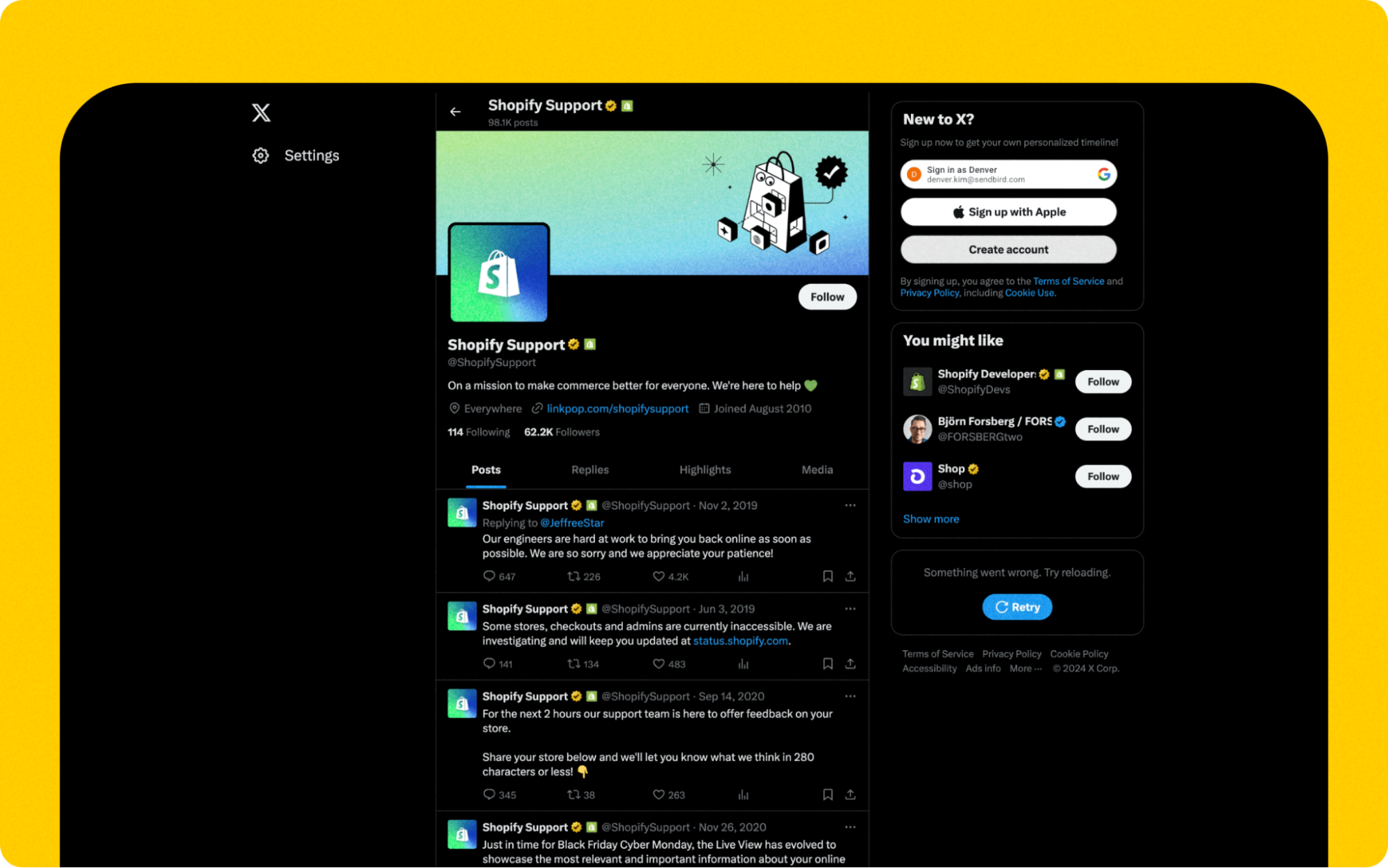
Ecommerce platform Shopify excels in customer support by using popular communication channels, including social media, to engage with users where they’re most active. For example, they maintain a dedicated support account on X (formerly Twitter), @ShopifySupport, where customers can tweet their issues and receive prompt assistance. This account not only allows for public engagement but also directs complex or sensitive conversations to private messages in order to protect privacy while providing more in-depth support.
Customer service
Zappos
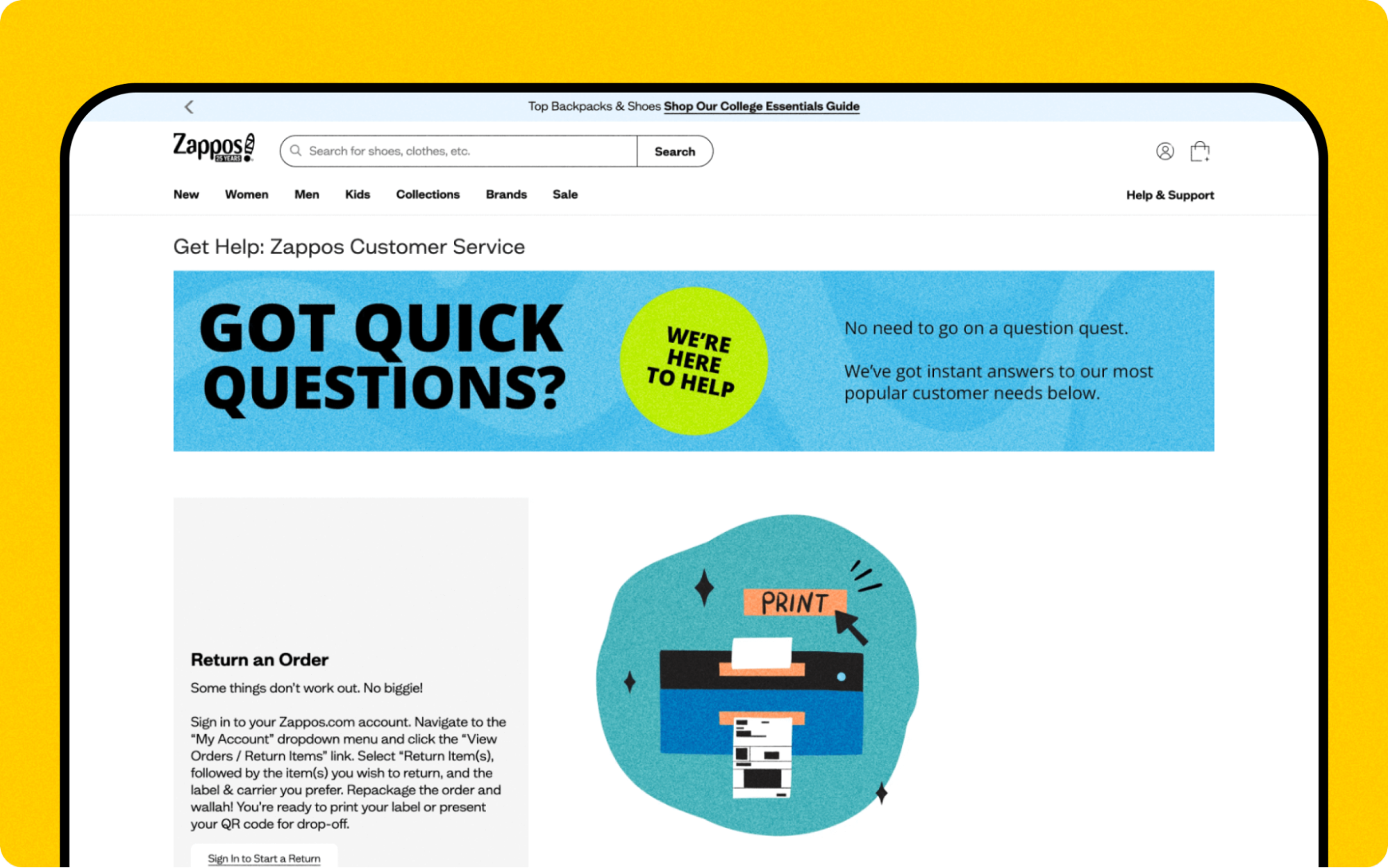
Online shoe retailer Zappos is known for their extraordinary customer service, which is rooted in their company culture committed to living and delivering “WOW.” They encourage representatives to build genuine relationships with customers, often spending significant time on calls to make sure they satisfy all customer needs. This commitment to service is reflected in their always free shipping and generous return policy — free return shipping and a full refund for 365 days after purchase — as well as consistently positive feedback from their customers.
Canva
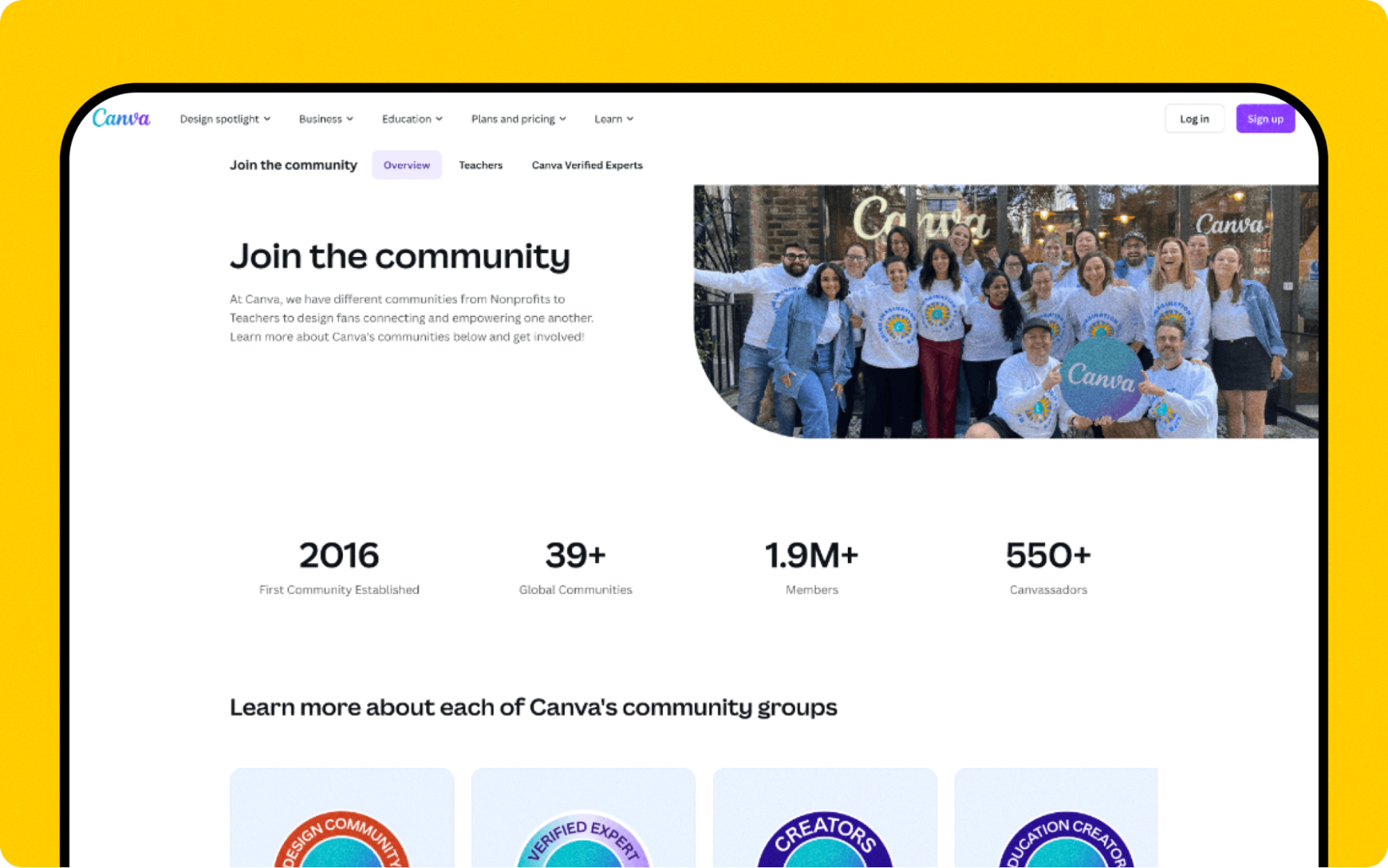
Canva aims to provide an excellent customer experience by fostering a strong sense of community among its users. The design platform actively engages with their user base through a range of interactive events like virtual workshops, meetups, and community events where users can share design tips and collaborate. Canva's Community Forums offer a platform for users to ask questions, exchange ideas, and receive support from fellow designers. Plus, their Canva Design School provides free online courses, helping users improve their design skills so they can make use of the platform's full capabilities.
Spotify

Music streaming service Spotify delivers exceptional customer service through a combination of personalized interactions, proactive communication, and a positive, customer-centric attitude. The company uses social media extensively to address customer inquiries and engage users, operating dedicated SpotifyCares accounts across different social platforms. They often go beyond solving problems to create a better experience for users; for example, after resolving a customer's issue, they might share a curated playlist to foster customer delight as opposed to simply customer satisfaction. SpotifyCares also posts videos, which answer all kinds of questions for customers, regularly on their YouTube channel.
6 tips for providing the best customer service and customer support
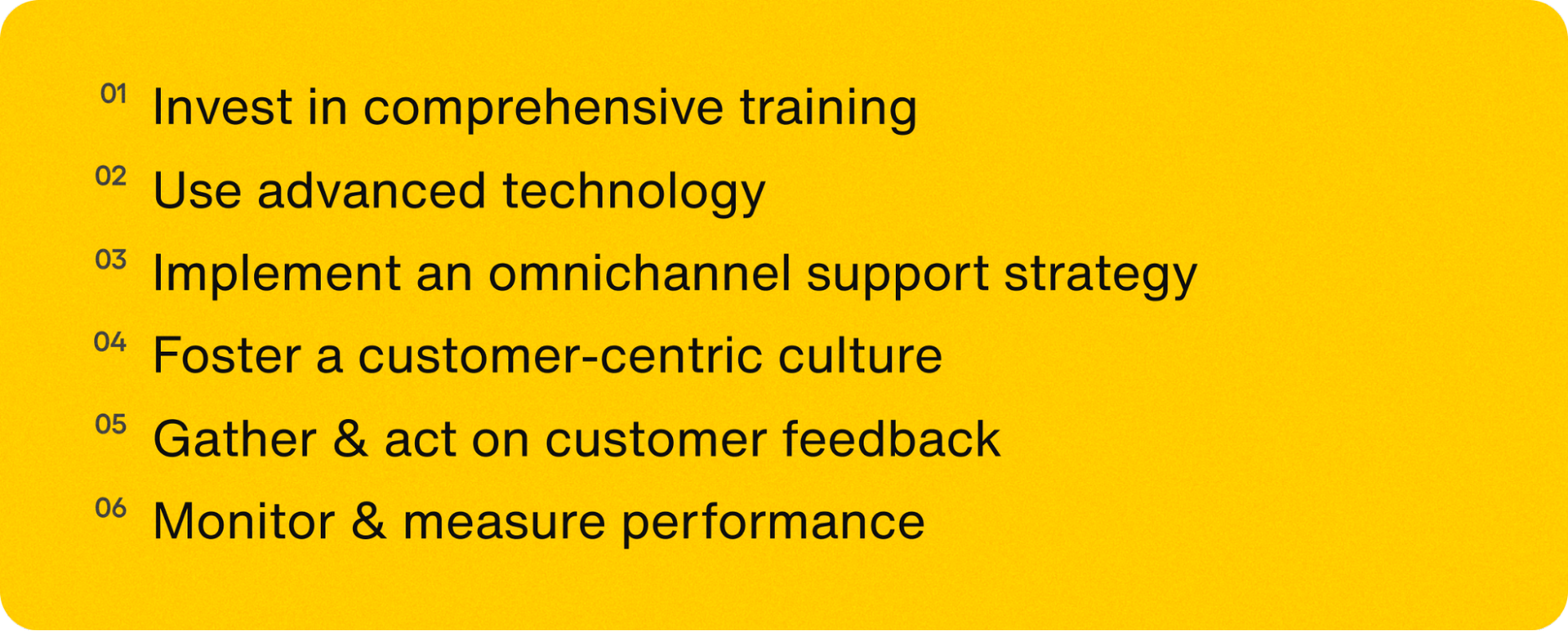
Delivering exceptional customer service and support is crucial for building lasting customer relationships and driving business success. Advanced tools, such as AI chatbots and support chat software software, are available to make this process easier and more achievable.
Let’s jump into six actionable tips to help your business excel in these areas, including how to put these and other tools to use to streamline your customer service program.
1. Invest in comprehensive customer service and customer support training
Develop robust training for your customer service and support teams to ensure a consistent, on-brand customer experience. Depending on the specific role, this education might cover both the technical aspects of your products and services, as well as the skills needed for effective customer interactions.
Keep in mind that staff training should be ongoing, especially as your product and service offerings evolve and change with time. Make sure to offer regular enablement sessions to keep team members updated on new products, services, and industry trends.
2. Use advanced customer support software
Today’s customers expect a seamless customer service experience, and delivering on those expectations is only possible by leveraging advanced technology. Incorporating sophisticated tools that offer a consistent omnichannel experience can streamline processes, improve response times, and enhance the overall customer experience. Here are some solutions to consider.
Implement AI-powered chatbots
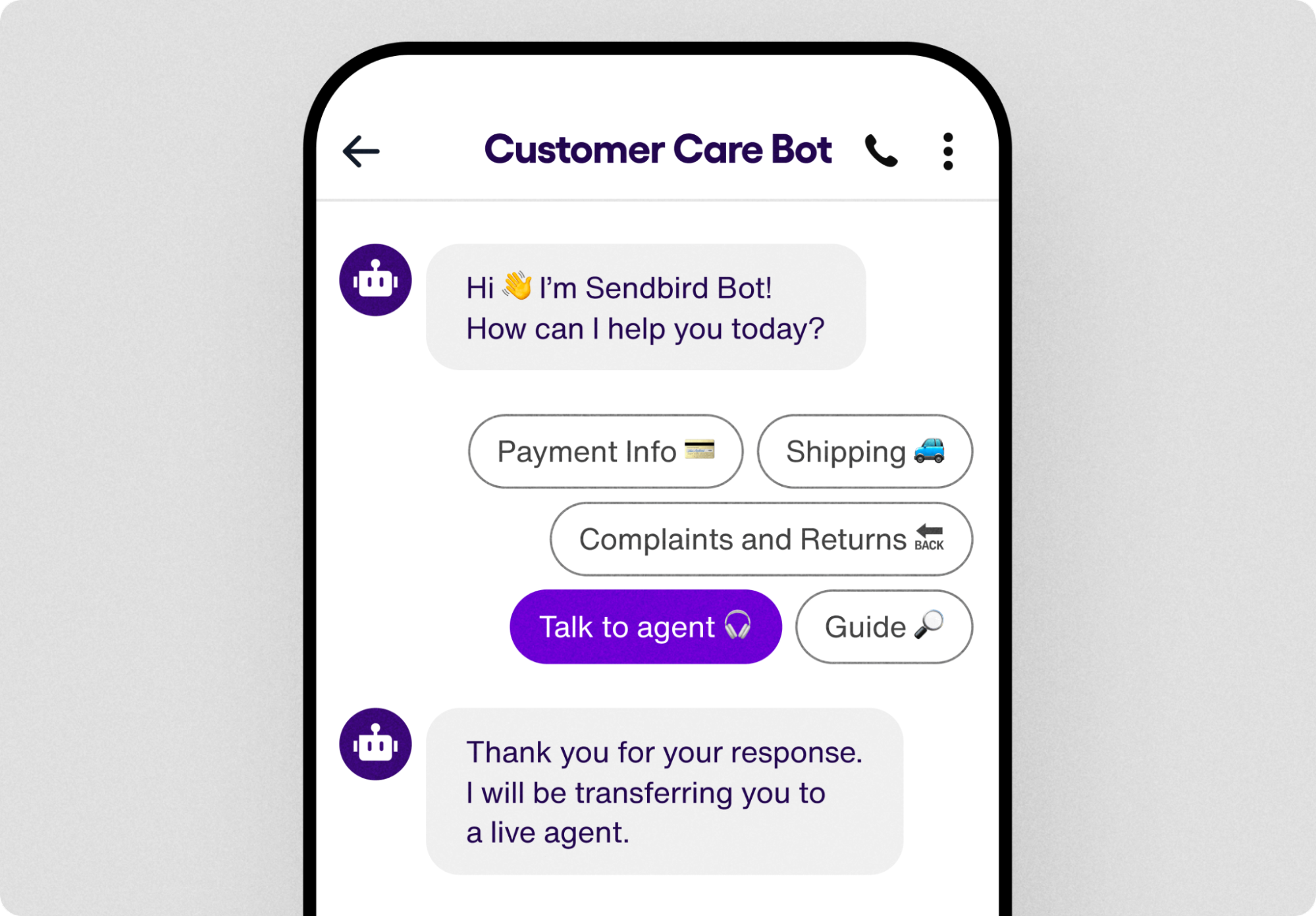
AI chatbots like Sendbird’s AI Chatbot help simplify customer support by automating responses, answering FAQs, and providing instant assistance. These chatbots use generative AI and customized workflows to understand and respond to customer inquiries accurately. Custom AI chatbots can handle a wide range of queries, from basic information requests to more complex problem-solving, helping reduce the burden on your human support agents.

Delight customers with AI customer service
Adopt all-in-one customer support solutions
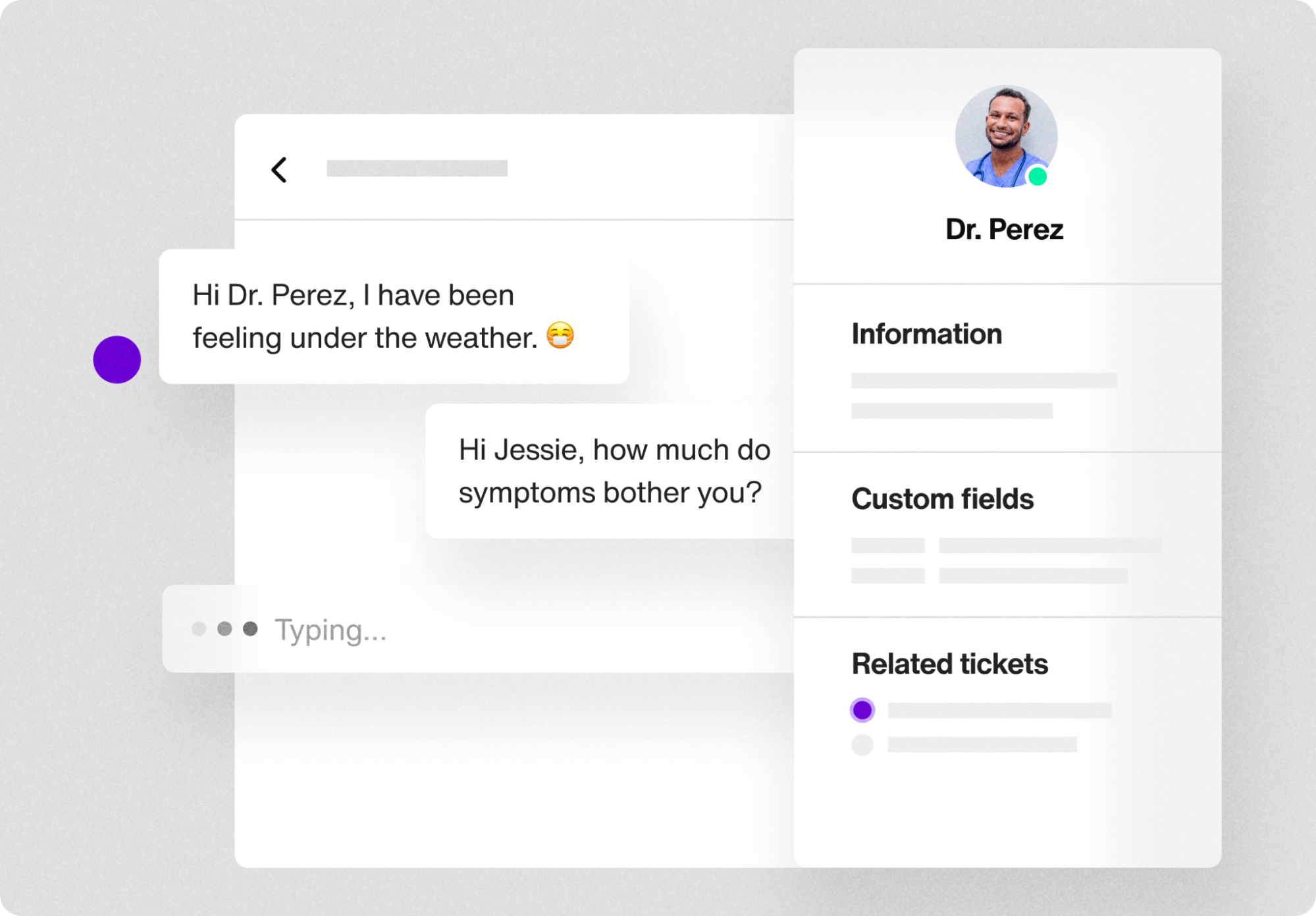
For businesses looking to centralize their support operations, Sendbird Desk offers an all-in-one customer support solution. This platform helps you automatically route tickets, integrate chatbots, automate common answers, and monitor performance through an easy-to-use customer support dashboard. Teams can track and prioritize customer issues effectively using a ticketing system.

Empower your support agents with AI
Integrate with your existing infrastructure
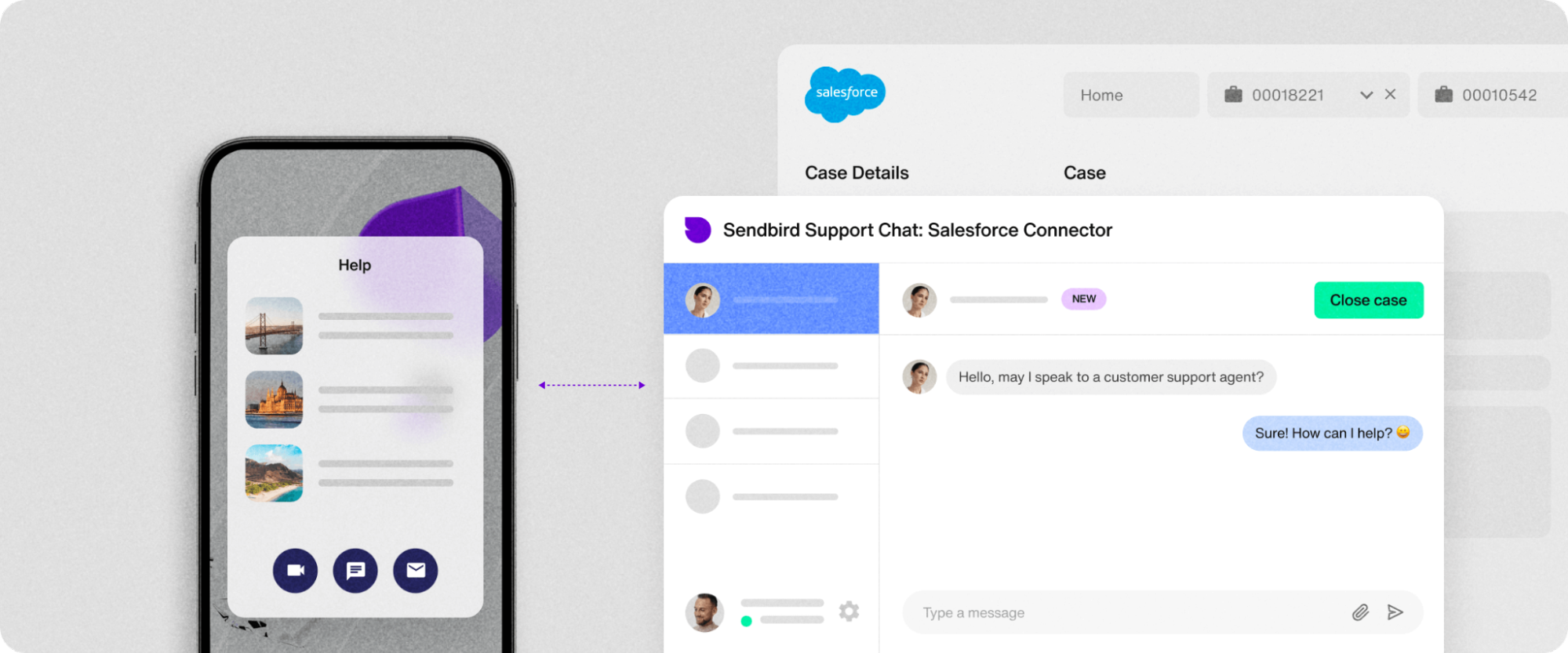
If you have existing customer support systems, integrating new tools can be challenging. However, existing tools don’t need to be a blocker with Sendbird’s Salesforce Connector, which facilitates seamless integration with Salesforce. This integration allows businesses to enhance their existing infrastructure through a feature-rich customer support solution embedded right within their Salesforce instance. Using the Salesforce Connector, customer service representatives can access comprehensive customer profiles and history so they can provide more personalized and efficient service. All the information agents need is provided within Salesforce, so that they are empowered to work on solving strategic customer inquiries without being bogged down by manual information gathering and summarizing tasks.
It's important to note that platforms like Salesforce don't focus directly on the chat experience for the customers seeking support. The Salesforce Connector solves this problem by offering an enhanced, feature-rich in-app support chat experience that allows for easy, intuitive information sharing. For example, customers can upload attachments, send reactions, and seamlessly talk to an agent with modern, sleek, in-app support chat.

Get an intelligent omnichannel support chat solution & drive rapid time to value
3. Implement an omnichannel support strategy
With an omnichannel support strategy, you allow customers to reach your business through a consistent, seamless experience across various digital touchpoints. Through multiple digital communication channels, you can cater to diverse customer preferences, making it easier for them to get the help they need in the most convenient way possible.
To be truly omnichannel, you must maintain a consistent tone and level of service across all channels by serving up the same messaging whether users contact you through phone, email, chat, or social media. To make this happen, make sure to develop unified response guidelines and cross-train your support staff.
An all-in-one platform like Sendbird Desk helps you manage live chat, email, and social media inquiries from a single dashboard.
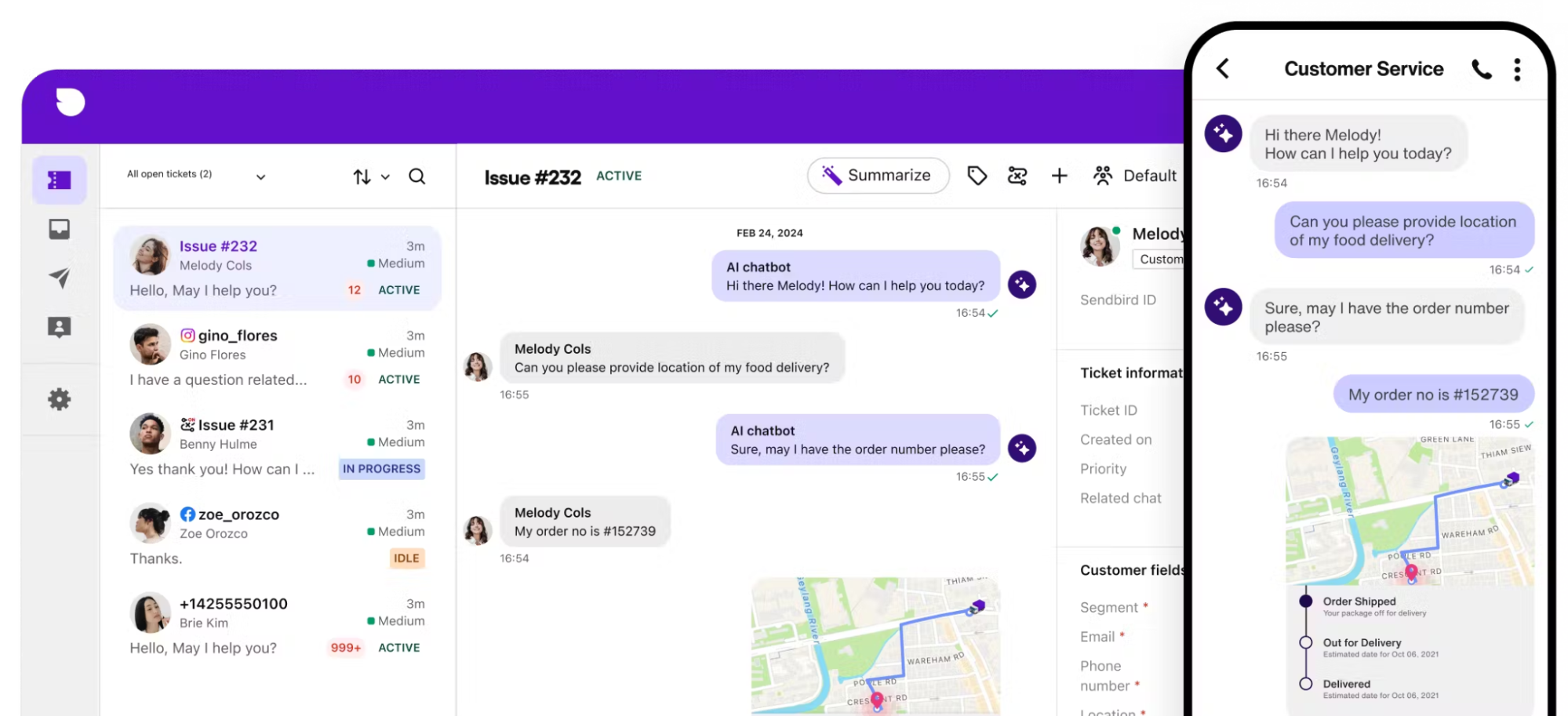
Having a centralized system enables your team to address customer issues promptly and consistently.

Empower your support agents with AI
4. Foster a customer-centric culture
Cultivate a customer-centric culture by placing the customer at the heart of all business operations and prioritizing customer needs and satisfaction in every interaction.
Start by defining and communicating core values, like empathy, responsiveness, and integrity, and integrating them into every aspect of the business — from product development to customer service. Make these values visible in the company’s mission statement and reinforce them in everyday operations. For example, Sendbird’s mission is to “build connections in a digital world.”
Business leaders must exemplify these values in their actions and behaviors to set the standard for the rest of the organization. Empower team members to make decisions that benefit the customer while recognizing and rewarding employees who go above and beyond to provide outstanding service to your customers.
5. Gather and act on customer feedback
It’s critical to be responsive to customer feedback and continuously improve your customer service and support offerings.
Implement formal mechanisms for regularly collecting customer feedback to better understand their needs and experiences. Feedback collection methods include email surveys, in-app polls, web forms, and interviews.
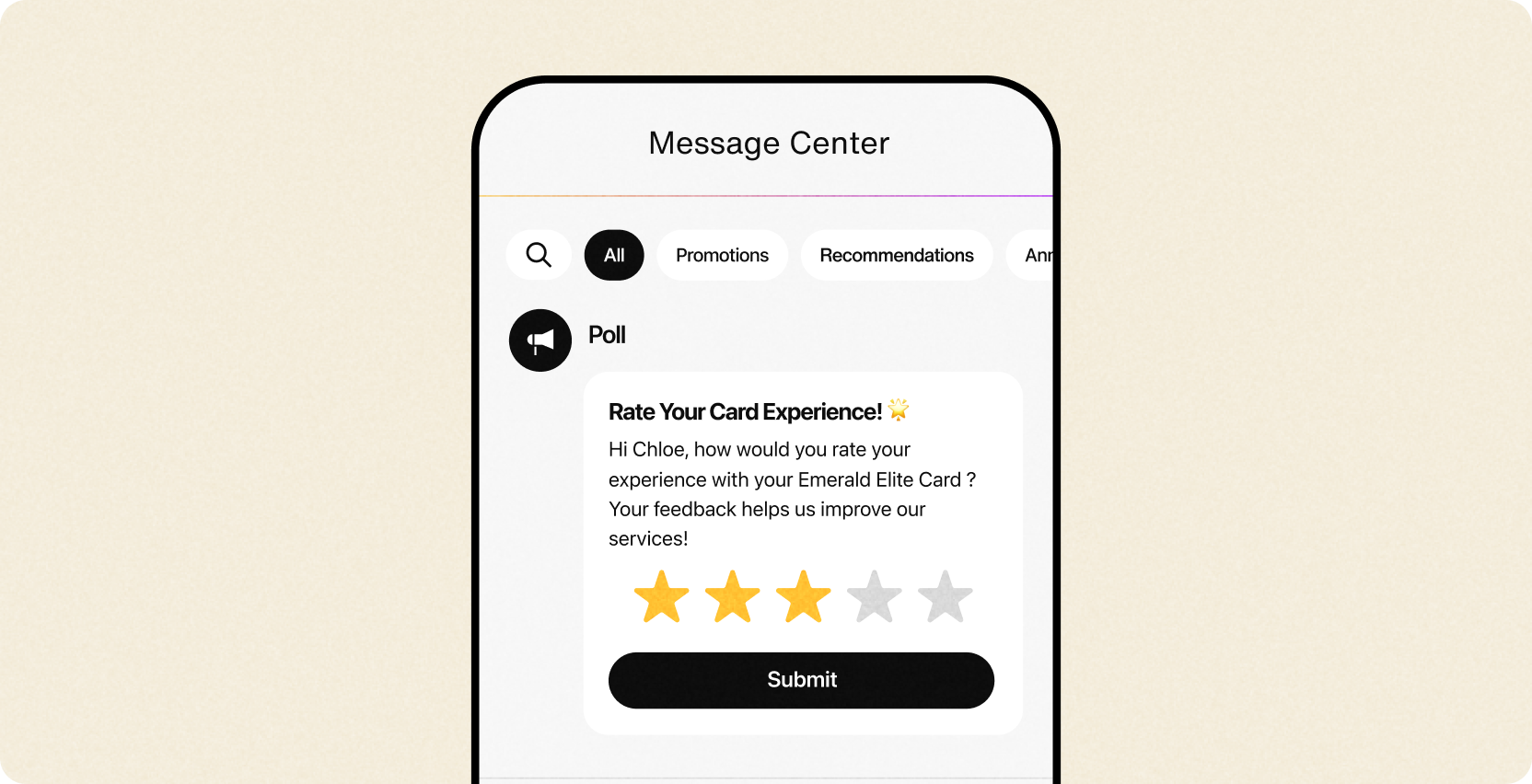
Once you’ve pinpointed areas for improvement, use these insights to make informed decisions and improve your products, services, and customer interactions. Prioritize the most critical issues first and outline specific steps to address them.
Finally, make sure that your current customers know about the changes you’re making in response to their input. Share the news with customers through your email newsletter or social media channels, and reach out directly to individual customers who provided notable feedback.
Remember that collecting customer feedback shouldn’t be an ad hoc scenario. Make this practice a natural part of your company culture, and regularly share customer and employee insights across the organization.
6. Monitor and measure performance
Track key customer support and service metrics to identify strengths and areas for improvement. Some common key performance indicators (KPIs) to help gauge the effectiveness of your customer service and support efforts include:
First response time: How quickly the team responds to an inquiry
Average resolution time: How long it takes to resolve an issue
Customer satisfaction (CSAT) scores or Net Promoter Scores (NPS): Showing how satisfied a customer is with their experience
Establish clear targets for each KPI based on industry benchmarks and company goals. For example, aim for a first response time of under 24 hours and a CSAT score above 90%.
Regularly analyze your customer service metrics to identify trends, patterns, and anomalies and make improvements where needed. But don’t just pay attention to the challenge areas; also be intentional about celebrating successes with your customer support and customer service teams, and double down on what works.
Improve your customer support and customer service game
There are critical differences between customer support and customer service. Customer support delivers targeted short-term assistance to resolve issues, while customer service encompasses all efforts to enhance the customer experience in the long term. Brands like Apple and Spotify exemplify the efforts that businesses can take to ensure customers have a positive experience with their company’s offerings.
The six strategies we shared can help businesses improve both customer support and customer service programs to deliver a better experience overall to your customer base and foster loyalty and business growth.
If you’re ready to transform your customer interactions, start a free trial of Sendbird’s AI Chatbot, Desk, or Salesforce Connector today and experience the difference that advanced technology can make in enhancing both customer support and customer service.

Empower your support agents with AI







